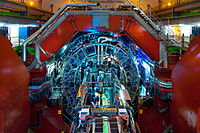
Photo from wikipedia
As part of its HL-LHC upgrade program, CMS is developing a High Granularity Calorimeter (HGCAL) to replace the existing endcap calorimeters. The HGCAL will be realised as a sampling calorimeter,… Click to show full abstract
As part of its HL-LHC upgrade program, CMS is developing a High Granularity Calorimeter (HGCAL) to replace the existing endcap calorimeters. The HGCAL will be realised as a sampling calorimeter, including 36 layers of silicon pads and 16 layers combining both silicon+scintillator detectors interspersed with metal absorber plates. Starting from 2016, prototype modules, based on 6-inch hexagonal silicon pad sensors with pad areas of 1.0 cm2, have been constructed. In 2017 and 2018, beam tests of different sampling configurations made from these modules have been conducted at CERN's SPS using beams of charged hadrons and electrons with momenta from 20 to 350 GeV/c. The setup was complemented with CALICE's AHCAL prototype, a scintillator-based sampling calorimeter, mimicking the proposed design of the HGCAL's scintillator part. Most importantly, the new Skiroc2-CMS readout ASIC has been used in the silicon modules, facilitating the study of its timing capabilities in practice. This talk summarises the test beam efforts in 2017 and 2018. Preliminary results, including gain characterisation, calibration with minimum ionising particles and energy reconstruction performance of electron induced showers are shown.
Journal Title: Journal of Instrumentation
Year Published: 2019
Link to full text (if available)
Share on Social Media: Sign Up to like & get
recommendations!